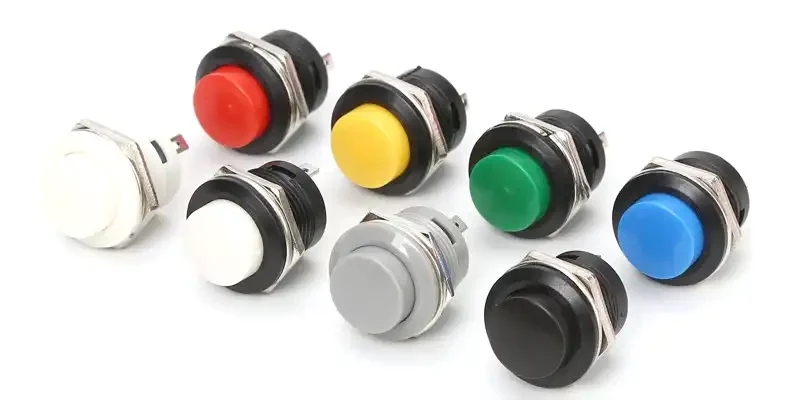What is a Push Button Switch?
A push button switch is a versatile electrical device that controls current flow in circuits with a simple press. Common in homes, workplaces, and various environments, these switches are crucial components in modern electronics and mechanical systems. Typically made of plastic or metal, push buttons can be flat or ergonomically shaped for easy use. When pressed, they complete a circuit, allowing current to flow. Push button switches come in various types, including momentary, latching, and illuminated versions, each serving different functions. They operate using either a basic electrical or air switch mechanism and can be momentary or latching in action. These switches are essential for efficient control in applications ranging from household appliances to complex industrial machinery, offering an intuitive and reliable way to activate or deactivate functions.
Structure of push button switch
The push button switch generally consists of a button cap, a return spring, a bridge-type moving contact, a static contact, a pillar connecting rod and a shell.
Working principle
- Actuation: When the button is pressed, it engages an internal mechanism that typically consists of a spring and electrical contacts. The pressure applied to the button compresses the spring and moves the internal contacts into a position where they either connect or disconnect, depending on the type of switch.
- Contact Types:
- Normally Open (NO): In this configuration, the circuit is open when the button is not pressed. Pressing the button closes the circuit, allowing current to flow. This is common in applications like doorbells and momentary switches.
- Normally Closed (NC): Here, the circuit is closed when the button is not pressed. Pressing the button opens the circuit, interrupting current flow. This type is often used in safety applications, such as emergency stop buttons.
- Return Mechanism: Upon releasing the button, a spring mechanism returns it to its original position. This action restores the circuit to its previous state—either open or closed—depending on whether it was a NO or NC switch.
Check the video about how the push button works
Push Button Switch Types
Push button switches come in various types, categorized based on different characteristics:
Shape-Based Types:
- Square: These switches feature a large square-shaped button or actuator. Their ample surface area makes them popular in industrial applications.
- Round: Characterized by their circular shape and compact size, round push button switches are commonly found in home appliances and consumer electronics due to their ergonomic design and durability.
Configuration-Based Types:
- Single Pole Single Throw (SPST): The most common type, featuring one pole and one throw. These switches are typically used to disconnect or reconnect a single conductor in a single branch circuit.
- Single Pole Double Throw (SPDT): These switches have one pole and two throws or output terminals, allowing control of multiple circuits by selecting one of two output states.
Functionality-Based Types:
- Momentary Switches: These remain active only while the actuator is pressed. Upon release, the circuit breaks, interrupting current flow. Doorbells and buzzer bells are common examples.
- Latching Switches: These switches maintain their position once pressed until activated again. Pressing the button once changes the switch state, which remains until pressed again. A typical on-and-off switch in homes exemplifies this type.
Push Button Switch Voltage Ratings
Push button switches are available in various voltage ratings, crucial for their suitability in different applications. Understanding these ratings is essential for proper selection and safe operation.
Common Voltage Ratings:
- Low Voltage: Many switches are rated for up to 32 VDC, ideal for low-voltage applications.
- Standard Range: Typical ratings span from 12 VDC to 250 VAC, depending on design and use.
- Specific Examples: Some momentary switches handle 5 mA at 32 VDC, while others are rated for 3A at 125VAC or 1.5A at 250VAC.
AC vs. DC Considerations:
- Different Ratings: AC and DC switches often have distinct voltage ratings due to varying current flow characteristics.
- Circuit Compatibility: It’s crucial to choose a switch designed for either AC or DC circuits as per the application.
Load and Environmental Factors:
- Load Type: Resistive and inductive loads affect voltage ratings differently. Inductive loads may require switches with higher inrush current capabilities.
- Environmental Protection: Some switches have additional ratings (e.g., IP67) for dust and water resistance, crucial for outdoor or industrial use.
Selection Guidelines:
- Manufacturer Specifications: Always consult the manufacturer’s datasheet for precise voltage and current ratings.
- Application-Specific: Consider the intended use, as ratings can vary widely between miniature and industrial models.
How to select the button switch?
Push button switches are versatile components that require proper understanding for effective use and maintenance. To use them correctly, identify the switch type (momentary or latching) and install it according to manufacturer specifications, ensuring proper wiring and matching voltage ratings. Operate the switch as intended, either with continuous pressure for momentary switches or single presses for latching types.
How to use and maintain push button switches?
For maintenance, regularly clean the switch surface, inspect electrical connections, and check for physical damage. Test functionality periodically and consider environmental factors that may affect performance. Replace components or the entire switch when necessary, and always keep documentation on hand for reference. By following these guidelines, users can ensure optimal performance and longevity of their push button switches in various applications.
Push Button Manufacturers
| Company Name | Found Year | Country | WEB |
|---|---|---|---|
| Schneider Electric | 1836 | France | Schneider.com |
| Electro-Mech Components, Inc. (EMC) | 1966 | USA | electromechcomp.com |
| Electroswitch Power Switches and Relays | 1946 | USA | Electroswitch.com |
| OMRON Corporation | 1933 | Japan | OMRON.com |
| CHINT | 1994 | China | Chint.com |
| ABB Limited | 1883 | Switzerland | ABB.com |
| Eaton Corporation Inc. | 1911 | USA | Eaton.com |
| Toshiba Corporation | 1875 | Japan | Toshiba.com |




